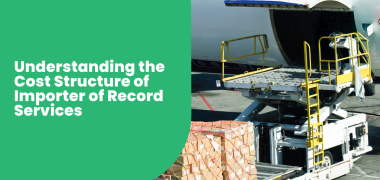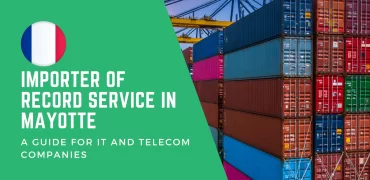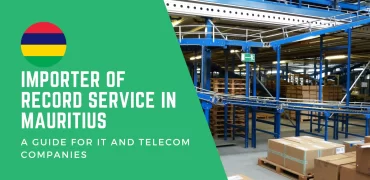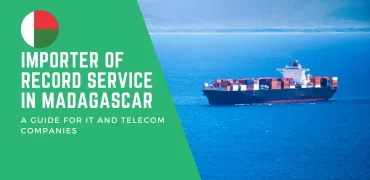In the realm of international trade, understanding the cost structure of Importer of Record (IOR) services is crucial for businesses aiming to expand their operations globally. The IOR plays a vital role in ensuring that imported goods comply with the regulations of the destination country, handling everything from customs clearance to documentation and payment of duties and taxes. This blog post aims to demystify the cost structure associated with IOR services, providing businesses with a comprehensive understanding of the financial implications involved.
What is an Importer of Record?
Definition and Role
An Importer of Record is an entity that takes responsibility for ensuring that imported goods meet all legal and regulatory requirements of the destination country. The IOR handles various tasks, including customs clearance, compliance with local laws, proper documentation, and the payment of all associated duties and taxes.
Key Responsibilities
- Customs Clearance: Facilitating the smooth entry of goods through customs.
- Compliance: Ensuring adherence to all relevant import regulations.
- Documentation: Managing necessary paperwork, such as invoices, packing lists, and certificates of origin.
- Duties and Taxes: Paying all required import duties and taxes.
Components of IOR Service Costs
Service Fees
The primary component of IOR service costs is the service fee charged by the IOR. This fee can vary widely depending on several factors, including the complexity of the import process, the value of the goods, and the specific services required.
- Flat Fees: Some IORs charge a flat fee for their services, which can simplify budgeting for businesses.
- Variable Fees: Other IORs may charge variable fees based on factors such as the value of the goods, the number of shipments, or the specific countries involved.
Customs Duties and Taxes
One of the most significant costs associated with importing goods is the payment of customs duties and taxes. These costs can vary greatly depending on the type of goods being imported and the regulations of the destination country.
- Import Duties: These are taxes imposed by the destination country on imported goods, usually calculated as a percentage of the goods’ value.
- Value-Added Tax (VAT) or Goods and Services Tax (GST): Many countries charge a VAT or GST on imported goods, which is also typically a percentage of the goods’ value.
- Excise Taxes: Certain goods, such as alcohol and tobacco, may be subject to additional excise taxes.
Documentation and Compliance Costs
Ensuring compliance with all relevant regulations and maintaining proper documentation can also incur significant costs.
- Document Preparation Fees: Some IORs charge fees for preparing and managing necessary documentation.
- Compliance Management Fees: Ensuring compliance with local regulations often involves additional costs, such as fees for obtaining necessary licenses or certifications.
Transportation and Logistics Costs
The costs associated with transporting goods from the supplier to the destination country can also be a significant component of the overall IOR service costs.
- Freight Costs: These are the costs associated with shipping the goods, which can vary depending on the mode of transport (e.g., air, sea, or land) and the distance involved.
- Insurance Costs: Insuring the goods during transit is often a necessary expense to protect against potential losses or damages.
- Warehousing Costs: Storing goods in warehouses before or after customs clearance can also add to the overall cost.
Factors Influencing IOR Service Costs
Type of Goods
The type of goods being imported can have a significant impact on the cost of IOR services. Different goods are subject to different import regulations, duties, and taxes.
- Regulatory Complexity: Goods that are subject to stringent regulations, such as pharmaceuticals or electronics, may incur higher compliance costs.
- Duty Rates: The import duty rates can vary widely depending on the type of goods, with some goods being subject to higher rates than others.
Destination Country
The regulations and requirements of the destination country also play a crucial role in determining the cost of IOR services.
- Import Regulations: Countries with more complex import regulations may require more extensive compliance efforts, leading to higher costs.
- Duty and Tax Rates: The rates of customs duties, VAT, and other taxes can vary significantly between countries.
Volume and Frequency of Shipments
The volume and frequency of shipments can also influence the cost of IOR services. Higher volumes and more frequent shipments can lead to cost efficiencies, while smaller, less frequent shipments may incur higher per-unit costs.
- Economies of Scale: Businesses that import large volumes of goods may benefit from lower per-unit costs due to economies of scale.
- Bulk Discounts: Some IORs offer discounts for businesses that commit to regular, high-volume shipments.
Strategies for Managing IOR Service Costs
Negotiating Service Fees
One effective strategy for managing IOR service costs is to negotiate the service fees with the IOR. By understanding the cost structure and leveraging the potential volume of shipments, businesses can often negotiate more favorable terms.
- Request for Proposal (RFP): Issue an RFP to multiple IORs to compare service offerings and costs, using the competitive process to negotiate better rates.
- Long-Term Contracts: Consider entering into long-term contracts with the IOR to secure more favorable pricing.
Understanding and Minimizing Duties and Taxes
Another key strategy is to understand the duty and tax rates applicable to the goods being imported and explore ways to minimize these costs.
- Tariff Classification: Ensure that goods are correctly classified under the appropriate tariff codes to avoid overpaying duties.
- Free Trade Agreements (FTAs): Take advantage of FTAs that may reduce or eliminate duties on certain goods.
Optimizing Transportation and Logistics
Optimizing transportation and logistics can also help manage IOR service costs. This can involve selecting the most cost-effective shipping methods and routes, as well as consolidating shipments to achieve cost efficiencies.
- Freight Consolidation: Combine multiple shipments into a single shipment to reduce transportation costs.
- Cost-Effective Shipping Methods: Evaluate the cost-benefit of different shipping methods (e.g., air vs. sea) and select the most cost-effective option.
Ensuring Compliance to Avoid Penalties
Ensuring compliance with all relevant regulations is crucial to avoiding costly penalties and fines. Working closely with the IOR to maintain proper documentation and adhere to local laws can help mitigate these risks.
- Compliance Audits: Regularly audit compliance processes to identify and address any potential issues before they lead to penalties.
- Training and Education: Invest in training and educating staff on compliance requirements to minimize the risk of non-compliance.
Case Study: Cost Management in IOR Services
Background
ABC Electronics, a mid-sized electronics manufacturer, sought to expand its market to several European countries. Faced with the complexity of European import regulations and the potential for high import duties and taxes, ABC Electronics decided to engage an IOR.
Implementation
ABC Electronics conducted a thorough RFP process, selecting an IOR with extensive experience in the electronics industry and a strong presence in Europe. The IOR provided a detailed breakdown of service fees, duties, and taxes, allowing ABC Electronics to budget accurately.
Results
- Cost Savings: By leveraging the IOR’s expertise and negotiating service fees, ABC Electronics achieved significant cost savings, reducing overall import costs by 20%.
- Efficient Compliance: The IOR’s knowledge of European import regulations ensured efficient compliance, avoiding costly penalties and delays.
- Optimized Logistics: The IOR helped optimize logistics, consolidating shipments and selecting the most cost-effective shipping methods, further reducing costs.
Conclusion
Understanding the cost structure of Importer of Record services is essential for businesses looking to expand their operations internationally. By breaking down the various components of IOR service costs, businesses can gain a clearer picture of the financial implications and make informed decisions. Key factors influencing these costs include the type of goods, the destination country, and the volume and frequency of shipments.
To manage IOR service costs effectively, businesses should consider negotiating service fees, understanding and minimizing duties and taxes, optimizing transportation and logistics, and ensuring compliance to avoid penalties. By implementing these strategies and working closely with a reputable IOR, businesses can achieve cost efficiencies and successfully navigate the complexities of international trade.
Final Thoughts
Expanding into new markets is a strategic move that can yield substantial growth opportunities for businesses. However, the complexities and costs associated with international trade can be daunting. Understanding the cost structure of Importer of Record services is a critical step in managing these challenges. By leveraging the insights and strategies outlined in this blog post, businesses can make informed decisions, optimize their import processes, and achieve their market expansion goals efficiently and cost-effectively.




